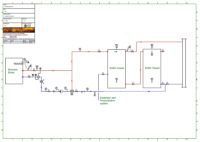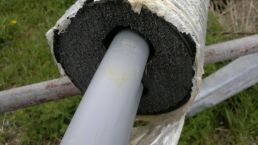
Given that biomass boilers require a buffer tank to effectively isolate them from varying load conditions, the correct hydraulic arrangement is imperative. If piped incorrectly, all stratification in the buffer tank can be destroyed, greatly reducing its capability to shield the boiler from periods of low load.

Primary side pipe work must be adequately sized to allow removal of excess head from the boiler. It is worth considering that, for example, a 200kW wood chip boiler may produce as much as 300kW of output for a short period of time. This is due to the inherent variation in the fuel. Primary side pipe work should therefore always be designed with spare capacity to ensure the safe removal of excess heat. This is particularly important for boilers with a relatively small amount of water in the heat exchanger or for boilers running near to their maximum design temperature. M Baxter biomass can provide a proven design to suite your installation.
The secondary side must be piped in a way that allows the biomass boiler to take the lead role, ensures the coolest possible return water temperature to the biomass boiler, and ensures that stratification in the buffer tank is not destroyed (eg. the flow should not exceed the primary side flow rate). Additional heat sources must be correctly connected and controlled to ensure that the biomass boiler works at maximum, and that peak load boilers automatically provide top up without interrupting the heat supply to the building during periods of heavy loading.

Biomass boilers are ideal for large district heating scenarios because the typically associated high system volume acts as an effective buffer. In some cases this can mean that a buffer tank is not required, but it is important that the circuits and controls are designed such that the boiler cannot be 'dead ended' at any time. Plastic district heating pipe can be utilised but the design temperature should not be too high because operational life of the pipe will be reduced and heat losses increased. The most important consideration of any district heating scheme is the pumping costs, as such the pipes should not be undersized for a small capital saving as the pumping cost can be greatly increased for the end user. The system should be designed to utilize a variable speed pump which responds to the changing demands of the variable consumers on the network. Again, incorporating such a system incurs additional capital costs, but can greatly reduce running costs creating savings in the long term. Contact Contact M.Baxter biomass for a high quality and cost effective district heating system design including pump sizing and specification.